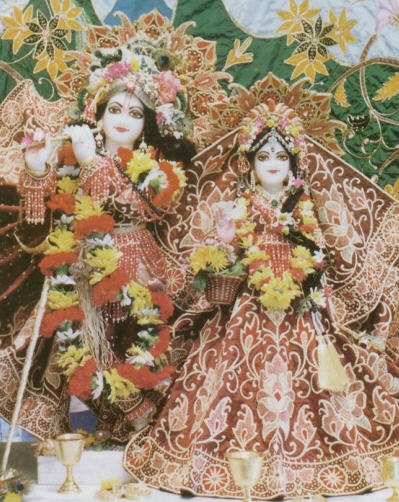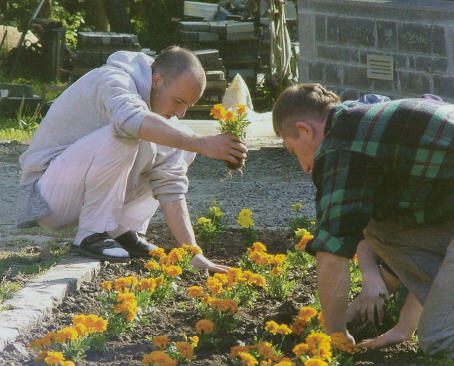In the Belgian Ardennes a Krsna conscious
community thrives around a medieval-style castle.

IN A SMALL LOCALE called Petite Somme, where the Ardennes forests and hills transform the otherwise flat landscape of Belgium and Holland, lies a thriving Krsna conscious community called Radhadesh. Standing prominently at the center of the community is the Chateau de Petite Somme, a well-known castle with a rich history going back to the thirteenth century. The present building, in neo-gothic style, dates to the nineteenth century. In World War II, American soldiers used the castle as a hospital during the famous Battle of the Bulge. It stood empty and deteriorating from 1975 until 1980, when ISKCON bought the property, which consisted of the castle, several other buildings, and forty-eight hectares (118 acres) of fields and woods. Devotees at once began renovation work that has gone on for over two decades.
The castle lies a little over a hundred kilometers from Brussels, the capital of Belgium and the European Union. Nature is generous in this part of Belgium practically no industries, no major cities, and more land per person than anywhere else in Benelux. Thick forests, abundant hills, and clear rivers make the area a popular destination for visitors, who come by the thousands every weekend and holiday from all over Belgium and Holland. History is everywhere: medieval towns and castles, stone barns and houses, and monuments to fallen soldiers from the fierce battles of WW II.
Radhadesh itself has become well known throughout Belgium and Holland, and about 45,000 visitors come every year to visit the castle and community, attracted by the beauty of the place and by the life of its special inhabitants. Eighty devotees live in and around the castle; about half are married.
Most of the devotees and visitors are from Holland and Flanders, the Dutch-speaking part of Belgium, where ISKCON has a good public image and good relations with governmental authorities. But Radhadesh is located in the French part of Belgium (called Wallonia), where the public image suffers because of the influence of France. In France, ISKCON and hundreds of other religious minorities are labeled as dangerous cults. The media, the Belgian government, and anti-cult organizations work hard to create a negative public image for any group they consider a cult. The devotees in Radhadesh are struggling to change that perception by reaching out to politicians, academics, the media, the local people, and established religious organizations.
Continual Renovations

In 1980, as soon as the castle was bought, the devotees began major renovation work. After several months, devotees and deities moved from Amsterdam to Radhadesh. Hrdaya Caitanya Dasa, temple president in Radhadesh since 1986, is originally from Belgium but decided to join ISKCON in Amsterdam. After only one night in the temple, he moved with many devotees to Radhadesh, where he has worked on almost every renovation and construction project.
The highlight of the rich makeover history is the new temple within the castle. It took a year to build, with beautiful marble from Carrarra, Italy, and a unique marble altar designed by Italian furniture designer and devotee Matsya Avatara Dasa. The temple is heated from beneath the floor, making it pleasant during the long winter months.
Slowly but steadily every building in Radhadesh has been renovated, transformed, and expanded under the expert guidance and hands-on involvement of Hrdaya Caitanya Dasa, who has built Radhadesh into one of the most beautiful ISKCON projects in the world. He has also inspired the devotees by his personal example of steadiness in his spiritual practices and eagerness to perform heaps of devotional service.
The last major project was the building of a large boutique, a new veranda-style cafeteria-restaurant, a conference room for over one hundred people, and a six-story guest house, in a style similar to the castle's. The guest house will include at least twenty guest rooms with attached bathrooms, as well as workshops, storage rooms, and apartments for Radhadesh residents.
Outreach Programs
Devotees at Radhadesh have several programs for spreading Krsna consciousness, including festivals, book distribution, street chanting, Food for Life, and seminars for the congregation. Yet the unique form of spreading Krsna consciousness that Radhadesh is famous for is the guided tours of the castle. These include an audio-visual presentation; a visit to the temple, with an introductory talk on Krsna consciousness; a long climb up the tower for a breathtaking view of the property and the region; a visit to the Prabhupada room, with its unique stained-glass window depicting the ten incarnations of Krsna; and a visit to the book room, where visitors can buy Srila Prabhupada's books. Before leaving the castle, guests can see a live Bharat Natyam dance performance.
The tour guide then escorts the group from the castle to another building, where they visit the bakery, the boutique, and the cafeteria-restaurant. Many groups choose to take a vegetarian meal in Radhadesh as part of their trip.
Organized tours of the castle began around 1987 and have been developing ever since. In 1989 Ramananda Raya Dasa signed a contract with a bus company to visit Radhadesh with over a hundred buses each year. Once in 1989, seventeen buses arrived in one day. Now at least two hundred buses visit Radhadesh each year. Ramananda Raya Dasa has dedicated his energy to making this program a success.
Five or so devotees welcome and guide the visitors. The tours are a main source of income for the community.
Focus On Education
Radhadesh has developed several educational programs. The first, the Bhakta Program, helps prospective devotees from city temples like Antwerp and Amsterdam become familiar with Krsna conscious philosophy and practices while living in a peaceful environment. A day school, started in the late eighties, is open to the community's children. Radhadesh has become a regular setting for seminars, such as the Teacher Training Course, the Communications Course, and the Bhakti-sastri Course. Most important, the ISKCON Convention has taken place in Radhadesh for over ten years. Around 130 devotees come together from all over the world for five days of learning in an atmosphere of surcharged spiritual association.
This year the Bhaktivedanta College, run by Bhaktivedanta Library Services (BLS), will launch a nine-month ministerial course for devotees from Europe. The course will provide systematic training in many fields of knowledge related to the Krsna conscious way of life. Visnu Murti Dasa and Yadunandana Dasa will direct the project, which will start on September 9 with a pilot course.
To support Radhadesh's emphasis on education, the BLS also manages a new library, opened on June 30. Still in development, it will offer a wide selection of Vedic texts, Vaisnava literature, and books on subjects such as philosophy, comparative religion, and new religious movements. The library will include audio, video, and other media. It is open to students of Bhaktivedanta College, members of the Radhadesh community, and visitors.
A High Standard Of Worship
Sri Sri Radha-Gopinatha, the presiding deities in Radhadesh, were installed in February 1977 in Amsterdam and moved to Radhadesh three years later. Srila Prabhupada himself installed Radhadesh's deities of Jagannatha, Baladeva, and Subhadra in July 1972 in Amsterdam. The installation was filmed by Dutch television and is described in Srila Prabhupada-lilamrta, by Satsvarupa Dasa Goswami. Sri Sri Gaura Nitai were installed in Amster-dam in 1976.
Deity worship in Radhadesh is of a high standard: six opulent offerings a day and seven new outfits a year. As the only deities of Radha-Krsna and Jagannatha in the Benelux, they are very dear to all the devotees serving in those countries. In the Benelux, Lord Jagannatha sometimes performs his Rathayatra pastime four times in one year.
Nikunja Vasini Devi Dasi has been taking care of Sri Sri Radha-Gopinatha since just after Their installation. She and her husband, Prema Siddhi Dasa, oversee the deity worship.
This year, on Janmastami and Vyasa Puja (August 31 and September 1), Radhadesh is celebrating the twenty-fifth anniversary of the installation of Sri Sri Radha-Gopinatha and the thirtieth anniversary of the installation of Sri Sri Jagannatha, Baladeva, and Subhadra. Many devotees who helped set up ISKCON in the Benelux will be on hand to tell their stories and realizations from those early days.
Mahaprabhu Dasa, originally from Uruguay, joined ISKCON in Paris in 1982 after having studied political science at Syracuse University in New York. He is the vice president of Radhadesh. He and his wife, Asoka Devi Dasi, have an eight-month-old daughter, Susila.
